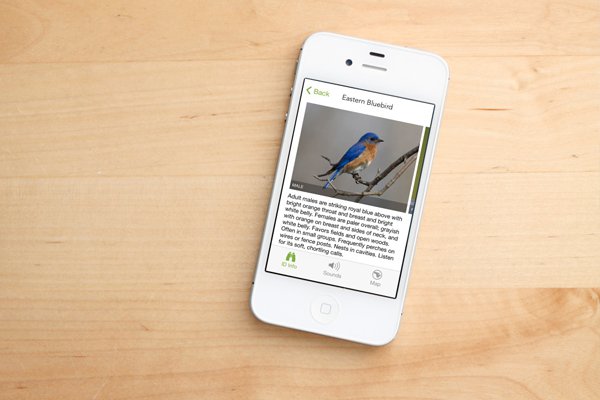by Carolyn Jabs

Bird Apps
Despite that sense of priority, 65% of parents in Brazil, China, France and Hong Kong as well as the United States, regard lack of time outdoors as a serious problem. The Children and Nature Network has compiled research connecting what it calls “nature deficit disorder” to attention problems and diminished awareness of the senses as well as physical inactivity and obesity.
Ironically, both of these organizations responded to this problem by developing websites. Naturerocks.org , a partnership between the Nature Conservancy and Disney, offers a rich collection of activities that will get kids outdoors to engage with the natural world, as well as an interactive map that points families toward beaches, campgrounds, aquariums and zoos.
The Children and Nature Network has a list of nature clubs for families. (childrenandnature.org/movement-directory)
Admittedly, going online in order to strengthen your family’s connection with the great outdoors may seem counter-intuitive. Yet, in our wired age, it makes no sense to ignore the many websites and apps that promise to inspire and support a deeper involvement with the world beyond the screen. Read on for a list of apps that are free and function on both Android and Apple platforms unless otherwise noted.
Where to Go
Yes, you can explore the natural world in your own backyard or in the park down the street, but when you have the urge for a bigger adventure, these apps can guide you.
NatureFind pinpoints all sorts of places where families can satisfy an appetite for exploration. In addition to nature centers and natural history museums, the website provides descriptions and directions for zoos, botanical gardens and wildlife refuges. A mobile version makes it easy to find activities on the go. (naturefind.com)
Oh, Ranger! Parkfinder provides concise information about city, state and national parks. A menu of activities allows you to search for parks where your family can pursue your favorite pastimes from bicycling, boating and birdwatching to camping, caving and climbing. (ohranger.com)
All Trails is a source for comprehensive information about 50,000 trails in the US and Canada. In addition to information about level of difficulty and scenery along the way, you’ll have access to comments from other hikers. The basic app is free. For $50 a year, you can get very detailed maps produced in a partnership with National Geographic. (Alltrails.com)
Knowing What You’re Looking At
Learning to identify living things is very satisfying, especially for children in elementary school. Many wonderful field guides are available as paid apps, and you may want to invest if your child shows an interest. To test the waters, try these apps which are both free and child-friendly.
Merlin Bird App was produced by the scientists at the Cornell Ornithological Lab. The app encourages children to observe carefully and zero in on a bird’s identity by answering five simple questions about appearance and behavior.
TreeBook is an app that includes photos, drawings, descriptions and range maps that will help kids identify the most common trees in North America. (tree-app.com)
Mywildflowers.com is a website run by a wildflower enthusiast. A very simple key prompts kids to answer questions about flower color and shape, as well as blooming season, leaf shape and plant size.
The National Parks Field Guide is an app crammed with photos that will make it easier to spot the flora and fauna typical of each national park. In addition to wildflowers and trees, the app covers birds, mammals, reptiles and amphibians. (wild.enature.com/apps)
Get Involved
A number of apps encourage users to take the next step and become citizen scientists, reporting their observations and taking action to preserve threatened species and habitats.
Project NOAH (Networked Organisms and Habitats) encourages wildlife lovers, young and old, to take photos of what they see and upload them online. The photos help scientists track wildlife populations. Additonally, a global community stands ready to help your child identify unknown plants and animals. (projectnoah.org)
Nature’s Notebook takes a different approach to observation. Your family can sign up to record changes in a specific site such as a favorite park or your own backyard. Then use the app to make regular field notes. Specific questions encourage children to notice seasonal changes for plants, birds and other creatures. Those observations become part of a database which helps scientists track changes in growing season and migration patterns. (usnpn.org)
iNaturalist, an app and a website, is the brain child of college students who wanted people to be able to share the photos of the animals, reptiles, birds, insects, and plants that they were already taking. Their ambitious goal is a “living record of life on Earth that scientists and land managers could use to monitor changes in biodiversity, and that anyone could use to learn more about nature.” Younger kids may need help in uploading photos and other information, but they will have the satisfaction of knowing that they are contributing to a massive database that records life on the planet. (inaturalist.org)
Of course, none of these apps are ends in themselves. Instead, think of them as bridges that will connect the virtual world in which most kids spend muchw of their time and the natural world where there are miracles waiting to be discovered.
Carolyn Jabs, M.A., raised three computer savvy kids including one with special needs. She has been writing Growing Up Online for ten years and is working on a book about constructive responses to conflict. Visit www.growing-up-online.com to read other columns.
Views: 0





